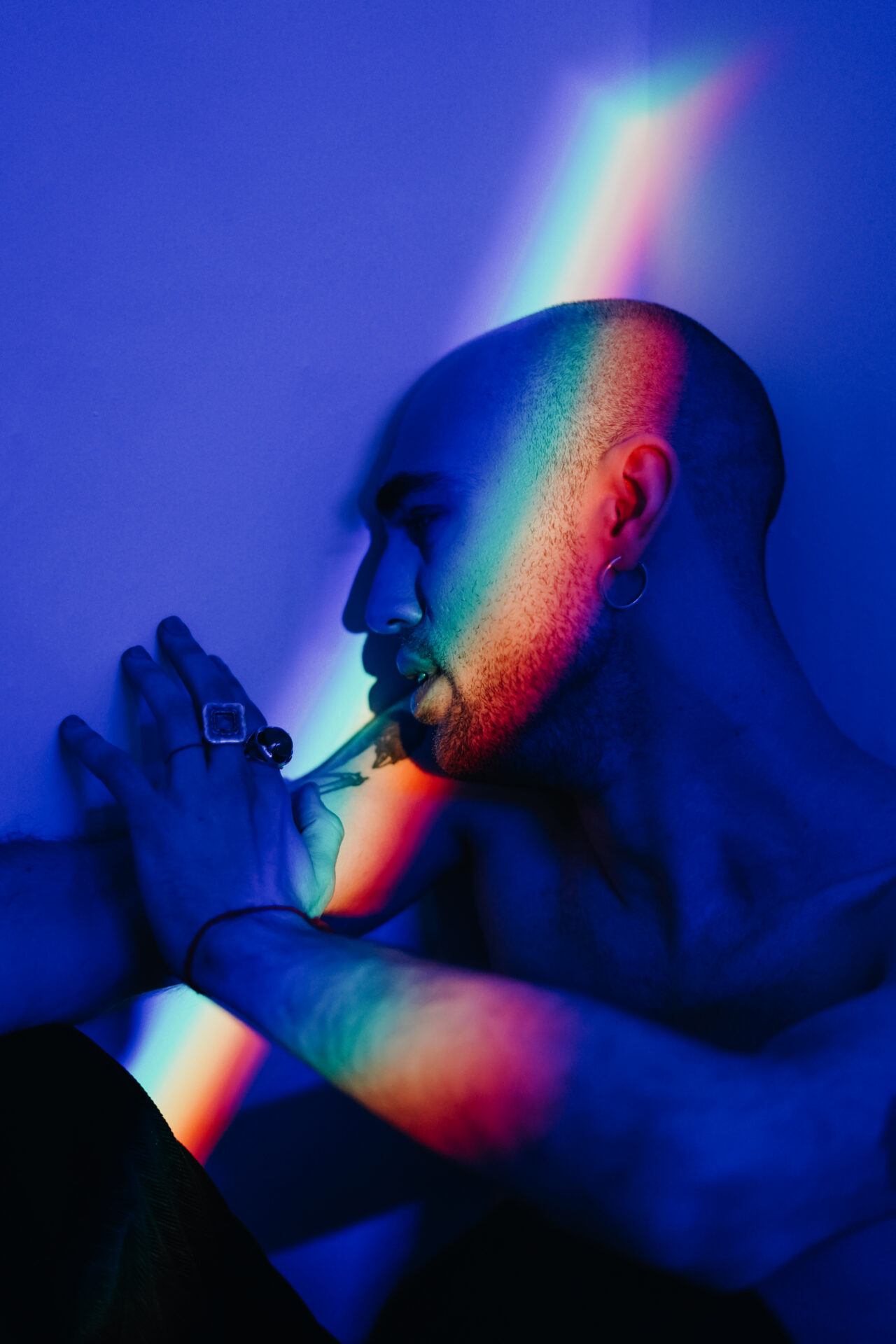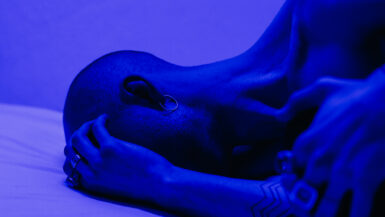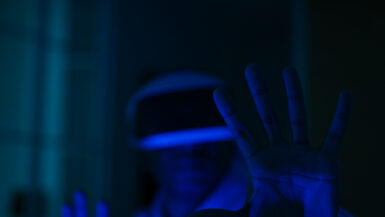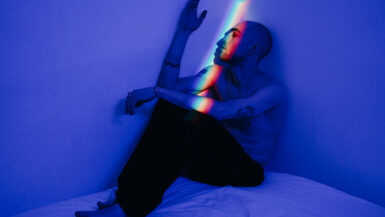In today’s world, exposure to blue light has become an unavoidable part of our daily lives, as we spend countless hours in front of screens and artificial light sources. This has led to growing concerns about the potential impact of blue light on our sleep patterns and overall productivity. Blue Light and Sleep: Myths vs. Facts aims to delve deep into the scientific research surrounding this topic, separating fact from fiction and providing our readers with an informed understanding of the true effects of blue light on our sleep quality and work performance. In this comprehensive article, we will examine the sources of blue light, its role in regulating our circadian rhythms, and the precautions that can be taken to minimize its negative impacts on our lives.
Understanding Blue Light and Its Sources
Blue light is a natural component of sunlight, but it is also emitted by various artificial sources that have become a significant part of our daily lives. In this subsection, we will explore the nature of blue light and its primary sources, both natural and artificial, to better comprehend its overall impact on our sleep and productivity.
The Electromagnetic Spectrum and Blue Light
Blue light is a part of the visible light spectrum, which is a small portion of the larger electromagnetic spectrum. This spectrum includes a range of wavelengths, from the shorter gamma rays to the longer radio waves. Visible light falls between ultraviolet (UV) light and infrared light, with blue light having a wavelength of approximately 380 to 500 nanometers. Due to its short wavelength, blue light has higher energy levels compared to other colors in the visible spectrum.
Natural Sources of Blue Light: The Sun
The primary natural source of blue light is the sun. During daylight hours, blue light wavelengths are responsible for the sky’s blue color, as they are scattered more effectively by the Earth’s atmosphere. Exposure to sunlight during the day helps regulate our circadian rhythm, which is crucial for maintaining healthy sleep patterns. It is important to note, however, that excessive exposure to sunlight’s harmful ultraviolet rays can be detrimental to our health.
Artificial Sources of Blue Light: Screens and Lighting
In addition to sunlight, blue light is emitted by many artificial sources, including digital screens (such as smartphones, tablets, and computers), LED lights, and compact fluorescent light bulbs. With the rise of technology and the increasing use of energy-efficient lighting, our exposure to blue light has significantly increased, particularly during the evening hours. This extended exposure to artificial blue light can potentially disrupt our sleep patterns and affect our overall well-being.
How Blue Light Impacts Our Sleep and Health
As mentioned earlier, exposure to blue light during the day can be beneficial for regulating our circadian rhythm. However, excessive exposure to blue light, especially during the evening, can interfere with our body’s natural sleep-wake cycle. To learn more about this topic, check out this article on How Blue Light Affects Sleep and Immune Function.
To sum up, understanding the sources of blue light is essential for recognizing its potential impact on our sleep and productivity. By being aware of both natural and artificial sources of blue light, we can make informed decisions about our exposure, ultimately leading to improved sleep quality and overall well-being.
Tips for Reducing Blue Light Exposure at Night
As we have already established, excessive exposure to blue light at night can have negative consequences on our sleep and overall health. In this section, we will provide practical tips for reducing blue light exposure during the evening hours, helping you maintain a healthy sleep-wake cycle and improve your productivity during the day.
Create a Screen-Free Bedroom Sanctuary
One of the most effective ways to reduce blue light exposure at night is to create a screen-free environment in your bedroom. By keeping televisions, computers, and smartphones out of your sleeping space, you can minimize your exposure to blue light before bedtime. This helps signal to your brain that it is time for rest, allowing you to fall asleep more easily and enjoy a more restorative night’s sleep.
Establish a Digital Curfew
Setting a digital curfew can be extremely helpful in reducing your exposure to blue light before bedtime. Aim to stop using electronic devices at least an hour before you plan to go to sleep. Instead, engage in relaxing activities such as reading a physical book, meditating, or practicing gentle stretches to help your body and mind unwind.
Utilize Blue Light Filtering Apps and Settings
Many electronic devices now offer built-in settings or apps that can help reduce blue light emission. These filters often adjust the color temperature of your screen to a warmer hue, which is less disruptive to your circadian rhythm. Make use of these features on your smartphone, tablet, and computer to minimize the blue light exposure, particularly during the evening hours.
Opt for Warmer Lighting in Your Home
The type of lighting you use in your home can also contribute to your exposure to blue light. Consider replacing cool-toned LED and fluorescent light bulbs with warmer, low-color temperature bulbs that emit less blue light. Additionally, try to dim the lights in your home during the evening hours to create a more relaxing atmosphere and prepare your body for sleep.
Consider Blue Light Blocking Glasses
If your work or lifestyle requires you to use electronic devices during the evening hours, consider investing in a pair of blue light blocking glasses. These specially designed lenses help filter out blue light, reducing its impact on your sleep-wake cycle. While this solution may not eliminate blue light exposure entirely, it can help mitigate its effects and promote better sleep.
By implementing these practical tips, you can effectively reduce your exposure to blue light at night, leading to improved sleep quality and heightened productivity during the day. Remember that maintaining a healthy balance is key to optimizing your overall well-being in our increasingly digital world.
Blue Light Exposure and Its Impact on Productivity
In this subsection, we will explore the relationship between blue light exposure and productivity, examining both the potential benefits and drawbacks of blue light on our cognitive performance and overall work efficiency. We will delve into the science behind blue light and its effects on our alertness and focus, as well as discuss strategies for managing blue light exposure to optimize productivity.
The Double-Edged Sword: Blue Light’s Influence on Alertness and Focus
Blue light exposure, particularly during the day, has been shown to have some positive effects on our cognitive performance. Due to its high energy levels and short wavelengths, blue light has been found to increase alertness, improve reaction times, and enhance mood. These effects can be beneficial for productivity, as they may help individuals stay focused and engaged during work hours.
However, the same properties of blue light that can boost our alertness during the day can also lead to sleep disturbances at night. As we have discussed in previous sections, excessive blue light exposure in the evening can disrupt our circadian rhythm and interfere with our ability to fall asleep and achieve restorative sleep. A lack of quality sleep can have detrimental effects on productivity, as it may result in reduced cognitive function, decreased focus, and increased fatigue the following day.
Managing Blue Light Exposure for Optimal Productivity
To harness the potential benefits of blue light exposure for productivity while minimizing its negative impacts on sleep, it is crucial to strike a balance in our daily exposure. Here are some strategies for managing blue light exposure to optimize productivity:
1. Maximize natural daylight exposure: Ensure that your work environment has ample access to natural daylight, as this can help regulate your circadian rhythm and support daytime alertness. If possible, position your workstation near a window or spend time outdoors during breaks.
2. Adjust screen brightness and color temperature: Modify the brightness and color temperature settings on your electronic devices to reduce blue light emission. Aim for a comfortable brightness level that does not strain your eyes and utilize warmer color temperatures during the later hours of the day.
3. Take regular breaks from screens: Prolonged periods of screen use can contribute to eye strain and fatigue, reducing productivity. Implement the 20-20-20 rule: every 20 minutes, take a 20-second break to look at something 20 feet away. This can help alleviate eye strain and maintain focus throughout the day.
4. Implement the tips from the previous section: Adopt the strategies mentioned earlier for reducing blue light exposure at night, such as establishing a digital curfew and using blue light filtering apps. By improving your sleep quality, you can enhance your cognitive performance and productivity during the day.
Ultimately, managing blue light exposure is essential for maintaining a healthy balance between alertness, focus, and quality sleep. By being mindful of our daily exposure and implementing strategies to optimize it, we can support our productivity and overall well-being in today’s digital age.
How Blue Light Affects Sleep Patterns
In this subsection, we will delve into the science behind the relationship between blue light exposure and sleep patterns. We will explore how blue light interacts with our body’s internal clock, the role of the hormone melatonin, and the potential consequences of disrupted sleep patterns due to excessive blue light exposure. Understanding these mechanisms is crucial for establishing healthy habits and minimizing potential sleep disturbances associated with blue light.
Blue Light and Our Body’s Internal Clock: The Circadian Rhythm
The circadian rhythm is our body’s internal clock, which regulates various physiological processes, including our sleep-wake cycle. This 24-hour cycle is influenced by external factors, such as light and darkness, with blue light playing a particularly significant role. When our eyes detect blue light, particularly during the daytime, it signals to our brain that it is time to be awake and alert. Conversely, the absence of blue light in the evening helps signal that it is time for rest and sleep.
Melatonin: The Sleep Hormone and Blue Light
Melatonin is a hormone produced by our body’s pineal gland, which plays a crucial role in regulating sleep. Our melatonin levels typically rise in the evening, remain high throughout the night, and decrease in the early morning hours. This hormonal fluctuation is essential for maintaining a healthy sleep-wake cycle.
Blue light exposure, particularly in the evening, can suppress melatonin production, leading to a delay in the onset of sleep and potential disturbances in sleep quality. By reducing melatonin levels, blue light exposure can disrupt our body’s natural sleep-wake cycle, making it harder for us to fall asleep and stay asleep.
Consequences of Disrupted Sleep Patterns Due to Blue Light Exposure
Disrupted sleep patterns caused by excessive blue light exposure can have various negative consequences on our overall well-being. Some of the potential impacts include:
1. Reduced sleep quality: Exposure to blue light before bedtime can lead to difficulties in falling asleep, frequent awakenings during the night, and reduced deep sleep stages, ultimately affecting our sleep quality and restorative functions.
2. Increased daytime sleepiness: A lack of quality sleep can result in increased daytime sleepiness, negatively impacting our productivity, focus, and mood.
3. Long-term health risks: Chronic sleep disruptions due to excessive blue light exposure can contribute to an increased risk of various health issues, such as obesity, diabetes, cardiovascular disease, and mood disorders.
4. Impaired cognitive function: Poor sleep quality can also affect our cognitive abilities, including memory, decision-making, and problem-solving skills.
By recognizing the science behind the relationship between blue light and sleep patterns, we can better understand the importance of managing our exposure to blue light, particularly during the evening hours. Adopting healthy habits, such as establishing a digital curfew and creating a screen-free bedroom environment, can help mitigate the potential negative impacts of blue light on our sleep and overall well-being.
Debunking Common Blue Light Myths
Despite the growing awareness about the effects of blue light on sleep, there are still many misconceptions and myths that persist. In this subsection, we aim to debunk some of the most common blue light myths and provide our readers with accurate, evidence-based information. By dispelling these misconceptions, we can develop a better understanding of the true impact of blue light on our sleep and overall well-being.
Myth 1: All Blue Light is Harmful
Contrary to popular belief, not all blue light is harmful. In fact, blue light is a natural component of sunlight and plays a crucial role in regulating our circadian rhythm. Exposure to blue light during the day can help increase alertness, improve mood, and support cognitive performance. It is excessive exposure to artificial blue light, particularly during the evening hours, that can disrupt our sleep-wake cycle and negatively impact our sleep quality.
Myth 2: Blue Light Blocking Glasses are a One-Size-Fits-All Solution
While blue light blocking glasses can be an effective tool for reducing blue light exposure, they are not a one-size-fits-all solution. The effectiveness of these glasses depends on factors such as the quality of the lenses, the specific wavelengths being blocked, and the individual’s unique sensitivity to blue light. Additionally, blue light blocking glasses should not be relied upon as the sole solution for minimizing blue light exposure; it is essential to adopt other healthy habits, such as establishing a digital curfew and creating a screen-free bedroom environment.
Myth 3: The Negative Effects of Blue Light are Limited to Sleep Disruption
Although sleep disruption is a primary concern related to excessive blue light exposure, the potential negative effects of blue light are not limited to sleep disturbances. Chronic exposure to artificial blue light has been associated with an increased risk of various health issues, such as obesity, diabetes, cardiovascular disease, and mood disorders. Therefore, it is essential to manage our exposure to blue light not only for the sake of our sleep quality but also to support our overall health and well-being.
Myth 4: Eliminating Blue Light Exposure Completely is the Best Approach
Completely eliminating blue light exposure is neither practical nor necessarily beneficial. As previously mentioned, blue light plays an essential role in regulating our circadian rhythm and supporting cognitive function during the day. The key is to strike a balance between natural blue light exposure during daylight hours and minimizing artificial blue light exposure during the evening. By finding this balance, we can harness the benefits of blue light while mitigating its potential negative impacts on our sleep and health.
By debunking these common blue light myths, we can develop a more accurate understanding of the relationship between blue light and sleep, and make informed decisions about managing our exposure. Through evidence-based information and practical strategies, we can maintain a healthy balance between the benefits and drawbacks of blue light, ultimately supporting our sleep quality and overall well-being in today’s digital age.





Leave a reply